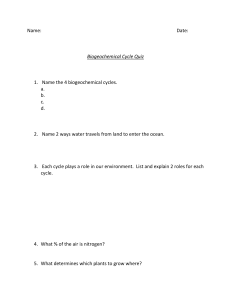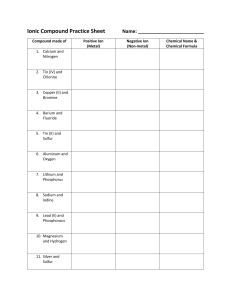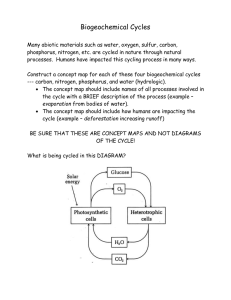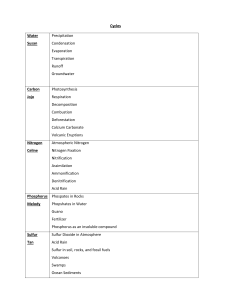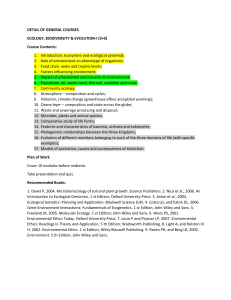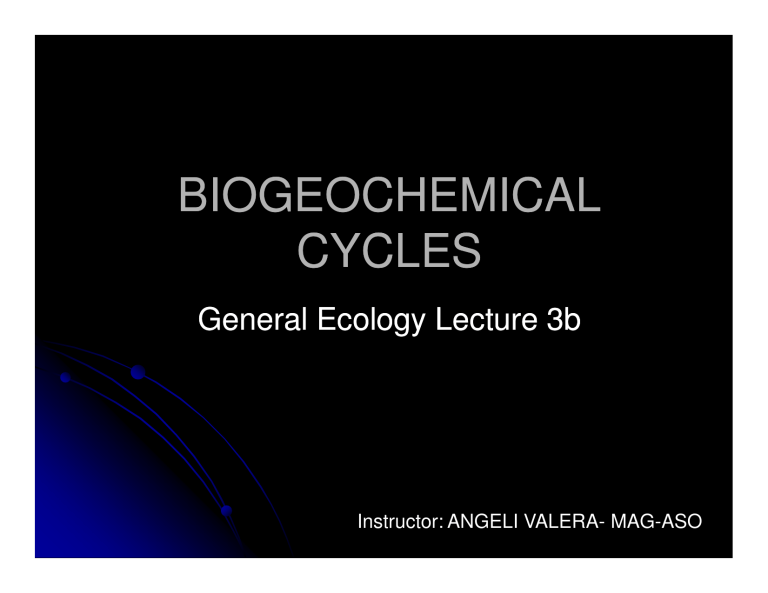
BIOGEOCHEMICAL CYCLES General Ecology Lecture 3b Instructor: ANGELI VALERA- MAG-ASO Objectives:: Identify and describe the flow of nutrients in each biogeochemical cycle. Explain the impact that humans have on the biogeochemical cycles. What Sustains Life on Earth? Solar energy, the cycling of matter, and gravity sustain the earth’s life. Figure 33-7 Two Secrets of Survival: Energy Flow and Matter Recycle An ecosystem survives by a combination of energy flow and matter recycling. Sources and sinks: domination of storage or release process of a specific material within a reservoir FLUX: exchange between two reservoirs CYCLE: system of connected reservoirs that transfer and conserve a specific material D. T. Krohne, General Ecology Fig .Idealized diagram of the geologic cycle, which includes the tectonic, hydrologic , rock and biogeochemical cycles. © 2003 John Wiley and Sons Publishers WATER CYCLE Condensation Rain clouds Transpiration Precipitation to land Transpiration from plants Precipitation Runoff Surface runoff (rapid) Evaporation Evaporation from land Precipitation Evaporation from ocean Surface runoff (rapid) Infiltration and Percolation Groundwater movement (slow) Ocean storage Precipitation to ocean Water’ Unique Properties There are strong forces of attraction between molecules of water. Water exists as a liquid over a wide temperature range. Liquid water changes temperature slowly. It takes a large amount of energy for water to evaporate. Liquid water can dissolve a variety of compounds. compounds. Water is the medium by which elements and other materials move through the ecosystem Water expands when it freezes. Effects of Human Activities on Water Cycle We alter the water cycle by: Withdrawing large amounts of freshwater. Clearing vegetation and eroding soils. Polluting surface and underground water. Contributing to climate change. CO2 & CH4 15%/year Modified from D. T. Krohne, General Ecology THE CARBON CYCLE © 2003 John Wiley and Sons Publishers Effects of Human Activities on Carbon Cycle We alter the carbon cycle by adding excess CO2 to the atmosphere through: Burning fossil fuels. Clearing vegetation faster than it is replaced. Figure 33-28 Fig 4.17 Global flux of carbon, 1850-1990. © 2003 John Wiley and Sons Publishers Idealized diagram illustrating photosynthesis for a green plant (tree) and generalized reaction. © 2003 John Wiley and Sons Publishers OXYGEN CYCLE Major sources: photodissociation of water vapor and photosynthesis Comines with a wide range of substances Ozone – produced by photochemical reactions in the atmophere; atmophere; essential to reduce influx of UV radiation to Earth FORMS OF NITROGEN 50% fertilizer (Bacteria) Modified from D. T. Krohne, General Ecology NITROGEN CYCLE NITROGEN CYCLE © 2003 John Wiley and Sons Publishers Nitrogen fixers: Cyanobacteria Free--living soil bacteria Free Bacteria associated with roots of leguminous plants Actinomycetes fungi, associated with roots of alders and other species of woody plants Effects of Human Activities on the Nitrogen Cycle We alter the nitrogen cycle by: Adding gases that contribute to acid rain. Adding nitrous oxide to the atmosphere through farming practices which can warm the atmosphere and deplete ozone. Contaminating ground water from nitrate ions in inorganic fertilizers. Releasing nitrogen into the troposphere through deforestation. Effects of Human Activities on the Nitrogen Cycle Human activities such as production of fertilizers now fix more nitrogen than all natural sources combined. Figure 33-30 Critical Thinking Issue – How are Human Activities Affecting the Nitrogen Cycle? Effects of increased use of nitrogen fertilizer: • Increased nitric acid in soil: • Leaching of magnesium and potassium • Increased aluminum levels • Plant root damage • Changes in microbe communities • Fish kills • Eutrophication of water bodies • Nitrates in drinking water • Global effects on plant based CO2 uptake © 2003 John Wiley and Sons Publishers Gaseous phase D. T. Krohne, General Ecology D. T. Krohne, General Ecology Modified from D. T. Krohne, General Ecology PHOSPHORUS CYCLE mining excretion Fertilizer Guano agriculture uptake by weathering autotrophs leaching, runoff Marine Dissolved Food in Ocean Webs Water death, decomposition sedimentation settling out uplifting over geologic time Marine Sediments uptake by autotrophs Dissolved Land in Soil Water, Food Lakes, Rivers Webs death, decomposition weathering Rocks PHOSPHORUS CYCLE © 2003 John Wiley and Sons Publishers Effects of Human Activities on the Phosphorous Cycle We remove large amounts of phosphate from the earth to make fertilizer. We reduce phosphorous in tropical soils by clearing forests. We add excess phosphates to aquatic systems from runoff of animal wastes and fertilizers. SULFUR CYCLE Water Sulfur trioxide Acidic fog and precipitation Sulfuric acid Ammonia Oxygen Sulfur dioxide Ammonium sulfate Hydrogen sulfide Plants Dimethyl sulfide Volcano Industries Animals Ocean Sulfate salts Metallic sulfide deposits Decaying matter Sulfur Hydrogen sulfide Effects of Human Activities on the Sulfur Cycle We add sulfur dioxide to the atmosphere by: Burning coal and oil Refining sulfur containing petroleum Convert sulfursulfur-containing metallic ores into free metals such as copper, lead, and zinc releasing sulfur dioxide into the environment – produce acute toxicity and major damage to vegetation (bleaching, defoliation and reduced growth); significant part of acid rain; irritates respiratory tract Ecosystems and the Gaia Hypothesis Ecosystem defined: a community of organisms and it’s corresponding abiotic environment through which matter cycles and energy flows • Wide variation in ecosystems • Boarders can be well defined or vague • Can be natural or artificial, managed or wild • Wide range in scale • Common to all ecosystems: energy flow and cycling of matter Gaia Hypothesis(es) • Life has greatly affected the planetary environment • This alteration has allowed life to persist • The Earth is a “super-organism” - Life controls the environment in a fashion that is equivalent to the way an organism controls its various systems •Has not been accepted by all ecologists and atmospheric scientists, but helps us to understand the behavior of ecosystems and the interaction of biogeochemical cycling. The Gaia Hypothesis: Is the Earth Alive? Some have proposed that the earth’s various forms of life control or at least influence its chemical cycles and other earthearth-sustaining processes. The strong Gaia hypothesis: life controls the earth’s lifelife-sustaining processes. The weak Gaia hypothesis: life influences the earth’s lifelife-sustaining processes.
